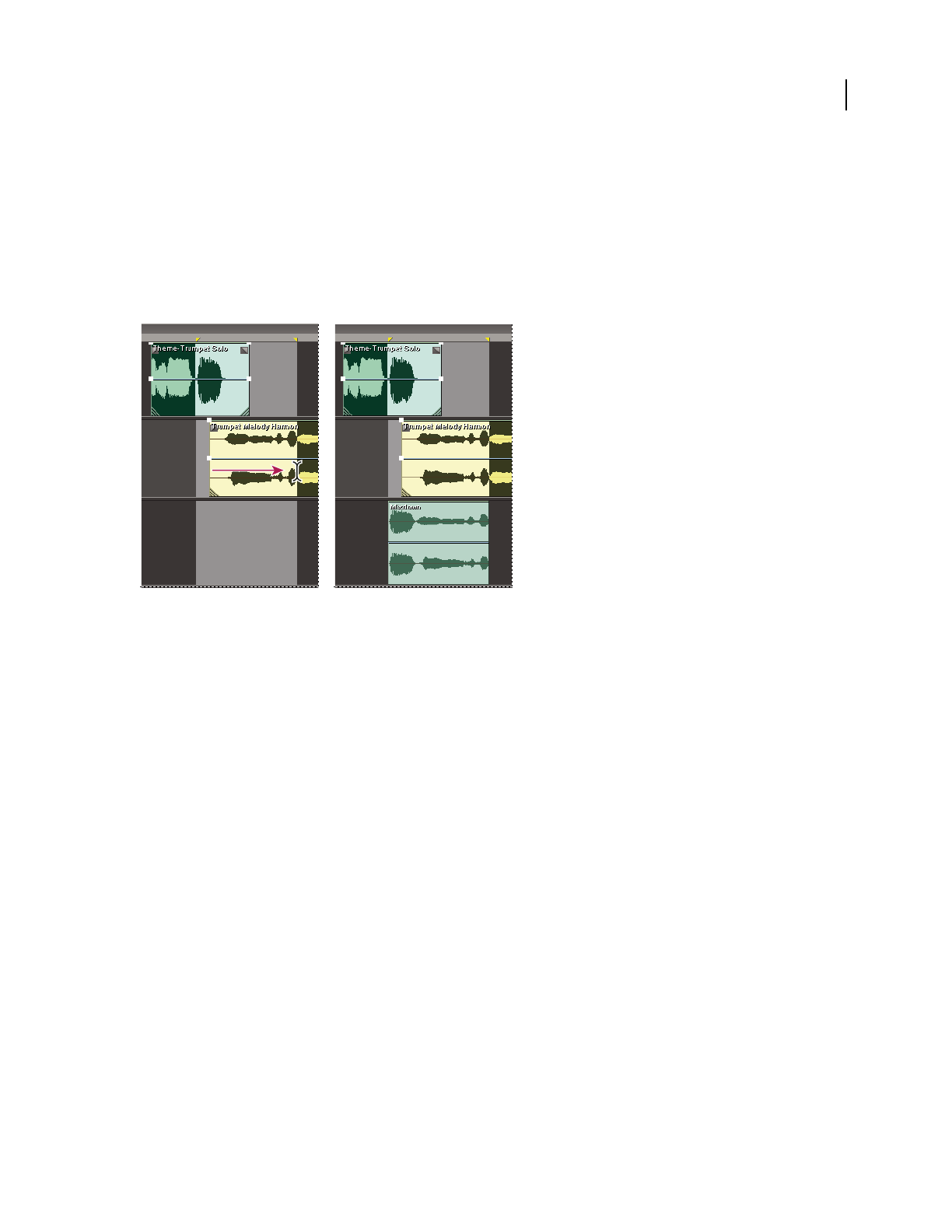Operation Manual
Table Of Contents
- Contents
- Chapter 1: Getting started
- Chapter 2: Digital audio fundamentals
- Chapter 3: Workflow and workspace
- Chapter 4: Setting up Adobe Audition
- Chapter 5: Importing, recording, and playing audio
- Chapter 6: Editing audio files
- Displaying audio in Edit View
- Selecting audio
- Copying, cutting, pasting, and deleting audio
- Visually fading and changing amplitude
- Working with markers
- Creating and deleting silence
- Inverting and reversing audio
- Generating audio
- Analyzing phase, frequency, and amplitude
- Converting sample types
- Recovery and undo
- Chapter 7: Applying effects
- Chapter 8: Effects reference
- Amplitude and compression effects
- Delay and echo effects
- Filter and equalizer effects
- Modulation effects
- Restoration effects
- Reverb effects
- Special effects
- Stereo imagery effects
- Changing stereo imagery
- Binaural Auto-Panner effect (Edit View only)
- Center Channel Extractor effect
- Channel Mixer effect
- Doppler Shifter effect (Edit View only)
- Graphic Panner effect
- Pan/Expand effect (Edit View only)
- Stereo Expander effect
- Stereo Field Rotate VST effect
- Stereo Field Rotate process effect (Edit View only)
- Time and pitch manipulation effects
- Multitrack effects
- Chapter 9: Mixing multitrack sessions
- Chapter 10: Composing with MIDI
- Chapter 11: Loops
- Chapter 12: Working with video
- Chapter 13: Creating surround sound
- Chapter 14: Saving and exporting
- Saving and exporting files
- Audio file formats
- About audio file formats
- 64-bit doubles (RAW) (.dbl)
- 8-bit signed (.sam)
- A/mu-Law Wave (.wav)
- ACM Waveform (.wav)
- Amiga IFF-8SVX (.iff, .svx)
- Apple AIFF (.aif, .snd)
- ASCII Text Data (.txt)
- Audition Loop (.cel)
- Creative Sound Blaster (.voc)
- Dialogic ADPCM (.vox)
- DiamondWare Digitized (.dwd)
- DVI/IMA ADPCM (.wav)
- Microsoft ADPCM (.wav)
- mp3PRO (.mp3)
- NeXT/Sun (.au, .snd)
- Ogg Vorbis (.ogg)
- SampleVision (.smp)
- Spectral Bitmap Image (.bmp)
- Windows Media Audio (.wma)
- Windows PCM (.wav, .bwf)
- PCM Raw Data (.pcm, .raw)
- Video file formats
- Adding file information
- Chapter 15: Automating tasks
- Chapter 16: Building audio CDs
- Chapter 17: Keyboard shortcuts
- Chapter 18: Digital audio glossary
- Index

ADOBE AUDITION 3.0
User Guide
201
Disable time stretching
1
Select a time-stretched clip, and choose Clip > Clip Time Stretch Properties.
2 Deselect Enable Time Stretching.
Create a single audio clip from multiple clips
You can combine the contents of multiple clips in the same time range, creating a single clip that you can quickly edit
in either Multitrack View or Edit View.
Creating single clip from multiple clips in Multitrack View
1 In the Main panel, do any of the following:
• Select a specific range to mix down. (See “Select ranges in Multitrack View” on page 181.)
• Select specific clips to mix down.
• Select nothing to mix down an entire session.
2 To combine the contents of the original clips, do either of the following:
• To create a track and clip in Multitrack View, choose Edit > Bounce To New Track.
• To create a file in Edit View, choose Edit > Mixdown To New File.
3 Choose a stereo or mono mixdown option.
See also
“Export a session to an audio file” on page 242
Create an audio clip from a bus, master, MIDI, or ReWire track
If you want to edit audio from a bus, master, MIDI, or ReWire track, create a clip from the track.
1 In the Main panel, select a time range for the new clip. (See “Select ranges in Multitrack View” on page 181.)
2 In the timeline, right-click a bus, master, MIDI, or ReWire track, choose Bounce [track type] To Track, and then
choose Stereo or Mono.
Adobe Audition creates a new track with a clip that reflects the bus, master, MIDI, or ReWire mix.










